|
|
|
|
|
|
|
|
|
A 'shunt-ahead' signal may be provided at a main stop signal that controls the entrance to the section ahead. When cleared, it authorises a train to pass the main signal for shunting purposes only, so that it may then set back through some trailing points. There were various designs of shunt-ahead signal [4.28 - 4.33].
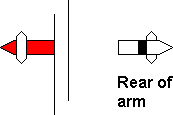 |
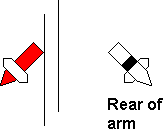 |
|
[4.28] Shunt-ahead Signal ('on').
Area: Cal.R / NBR Usage: Unknown Status: Historical |
[4.29] Shunt-ahead Signal ('off').
Area: Cal.R / NBR Usage: Unknown Status: Historical |
|---|---|
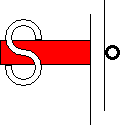 |
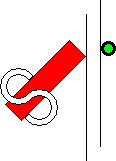 |
|
[4.30] Shunt-ahead Signal ('on').
Area: GWR Usage: Unknown Status: Historical |
[4.31] Shunt-ahead Signal ('off').
Area: GWR Usage: Unknown Status: Historical |
 |
 |
|
[4.32] Calling-on or Shunt-ahead Signal ('on').
Area: S&DJR Usage: Unknown Status: Historical |
[4.33] Calling-on or Shunt-ahead Signal ('off').
Area: S&DJR Usage: Unknown Status: Historical |
A 'warning' signal, when cleared, authorises the driver to proceed to the next stop signal. The driver must understand that the line is clear as far as the next stop signal only but might be obstructed immediately beyond it. The speed of the train must be regulated accordingly. Where provided, a warning signal was usually placed at a main stop signal that controlled the entrance to the section ahead.
Warning signals were uncommon at one time, although a few had been provided on the Great Central Railway for use in connection with Evans Lock and Block. These comprised a small centrally pivoted semaphore arm with a distinctive sloping end [4.34 & 4.35].
 |
 |
|
[4.34] Warning Signal ('on').
Area: GCR Usage: Low Status: Historical |
[4.35] Warning Signal ('off').
Area: GCR Usage: Low Status: Historical |
|---|
The LB&SCR later had some warning signals in the London District, working in conjunction with Sykes Lock and Block. These took the form of a rotating white disc or banner incorporating a 'bow-tie' arm in red [4.36 & 4.37].
 |
 |
|
[4.36] Warning Signal ('on').
Area: LB&SCR Usage: Medium Status: Historical |
[4.37] Warning Signal ('off').
Area: LB&SCR Usage: Medium Status: Historical |
|---|
Where the Great Western Railway provided banner type main signals (see [2.74 & 2.75]) and a calling-on signal was required, it took the form of a miniature banner endorsed "CO" on the arm [4.38 & 4.39].
 |
 |
|
[4.38] Banner Type Calling-on Signal ('on').
Area: GWR Usage: Low Status: Historical |
[4.39] Banner Type Calling-on Signal ('off').
Area: GWR Usage: Low Status: Historical |
|---|
In 1920, the GWR's Ealing & Shepherd's Bush Railway was provided with three-position semaphore signals working in the upper quadrant (see Section 2). Where calling-on signals were required, they comprised two-position semaphore signals (also working in the upper quadrant) endorsed "CO" on the arm, with one letter on either side of the white stripe [4.40 & 4.41].
 |
 |
|
[4.40] Calling-on Signal ('on').
Area: Ealing & Shepherd's Bush Railway Usage: Low Status: Historical |
[4.41] Calling-on Signal ('off').
Area: Ealing & Shepherd's Bush Railway Usage: Low Status: Historical |
|---|
|
The Great Northern Railway installed three-position upper quadrant semaphore signals at London King's Cross in 1922. Where a subsidiary signal was mounted below one of these signals, it took the form of a miniature two-position upper quadrant semaphore arm. A yellow light was shown at night for the "off" indication [4.42]. |
|
Where a main signal in the form of a large disc (see [2.103 & 2.104]) required an associated calling-on signal, the latter comprised a normal-sized disc endorsed "CO" [4.43 & 4.44].
 |
 |
[4.43] Disc Type Calling-on Signal ('on').

Area: GWR Usage: Low Status: Obsolescent |
[4.44] Disc Type Calling-on Signal ('off').
Area: GWR Usage: Low Status: Obsolescent |
|---|
The Ministry of Transport 'Requirements' of 1925 had stated that calling-on and shunt-ahead signals should display a white light when in the 'on' position (warning signals were not mentioned). It therefore followed that the colour of the signal arm should also be white, but since the appearance of the arm was not specified, each company's signals differed in detail. In September 1926, a calling-on signal comprising a small white arm with red horizontal stripes at top and bottom [4.45 & 4.46] was installed on the LNER at Cambridge.
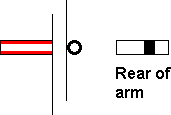 |
 |
|
[4.45] Subsidiary Signal ('on').
Area: All Areas Usage: High Status: Current |
[4.46] Subsidiary Signal ('off').
Area: Various Usage: Medium Status: Historical |
|---|
The GWR's resignalling at Newport in 1927/1928 included calling-on signals in the form of a small white arm with a red stripe, endorsed with a letter "C" [4.47 & 4.48].
 |
 |
|
[4.47] Calling-on Signal ('on').
Area: Newport, GWR Usage: Medium Status: Historical |
[4.48] Calling-on Signal ('off').
Area: Newport, GWR Usage: Medium Status: Historical |
|---|
|
|
|